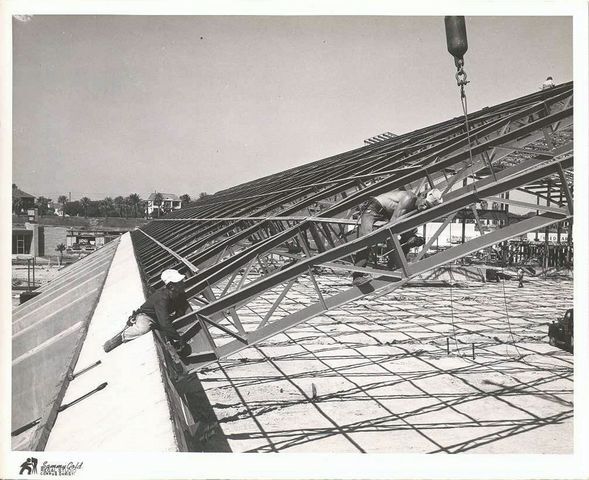In the early 1950s, the city contracted with architect Richard Colley to design a civic complex on the bayfront which would include 2 parks, a new City Hall (demolished in 1988), an Exposition Hall (demolished in 1984), and an events center (the Coliseum).

For the Coliseum, Colley chose a barrel-shaped building because, as he said, "a boxlike, conventional building would look like hell here." "The barrel shape offers the most contrast with the ground."
His “lamella” roof design used steel arches, anchored to concrete flying buttresses on either side to create a span of 224 feet and a height of 42 feet.

Inside, the design allowed for a totally unobstructed view of events because there were no support columns to get in the way.
The Coliseum's unique design earned Colley national recognition and an award for "best civic design" from Progressive Architecture Magazine.
In 1955, a photograph of the new Corpus Christi Memorial Coliseum appeared in the Yearbook of the Encyclopedia Britannica. In 1958, photographer John Waggaman did an extensive photographic layout of the Coliseum for the Carnegie Study of the Arts of the United States.
Our Coliseum was chosen because of its "significance in the history of American architecture" and it's "successful merger of beauty and functionality". That same year, a photograph of the Coliseum was displayed at the United States Pavilion of Expo '58....the World's Fair in Brussels.

The unique appearance and innovative construction techniques of Memorial Coliseum were featured in Time Magazine, Architectural Forum, Engineering News-Record, and the Architectural Record. It was also featured in the foreign publications L’architecture d’aujourd’hui (France), Techniques et Architecture (France) and Informes de la Construccion (Spain), just to name a few.
When it was completed in 1954, the 224 foot unsupported span of its roof was the longest in the world.

Construction began in February of 1953 and was completed in September of 1954.
It instantly became the most recognizable building on Corpus Christi’s bayfront skyline.
Robert Parks is a special contributor to KRIS 6 News. Parks was a history teacher at Carroll High School for 19 years and is now retired. His knowledge of Corpus Christi history makes him a unique expert in the subject.





